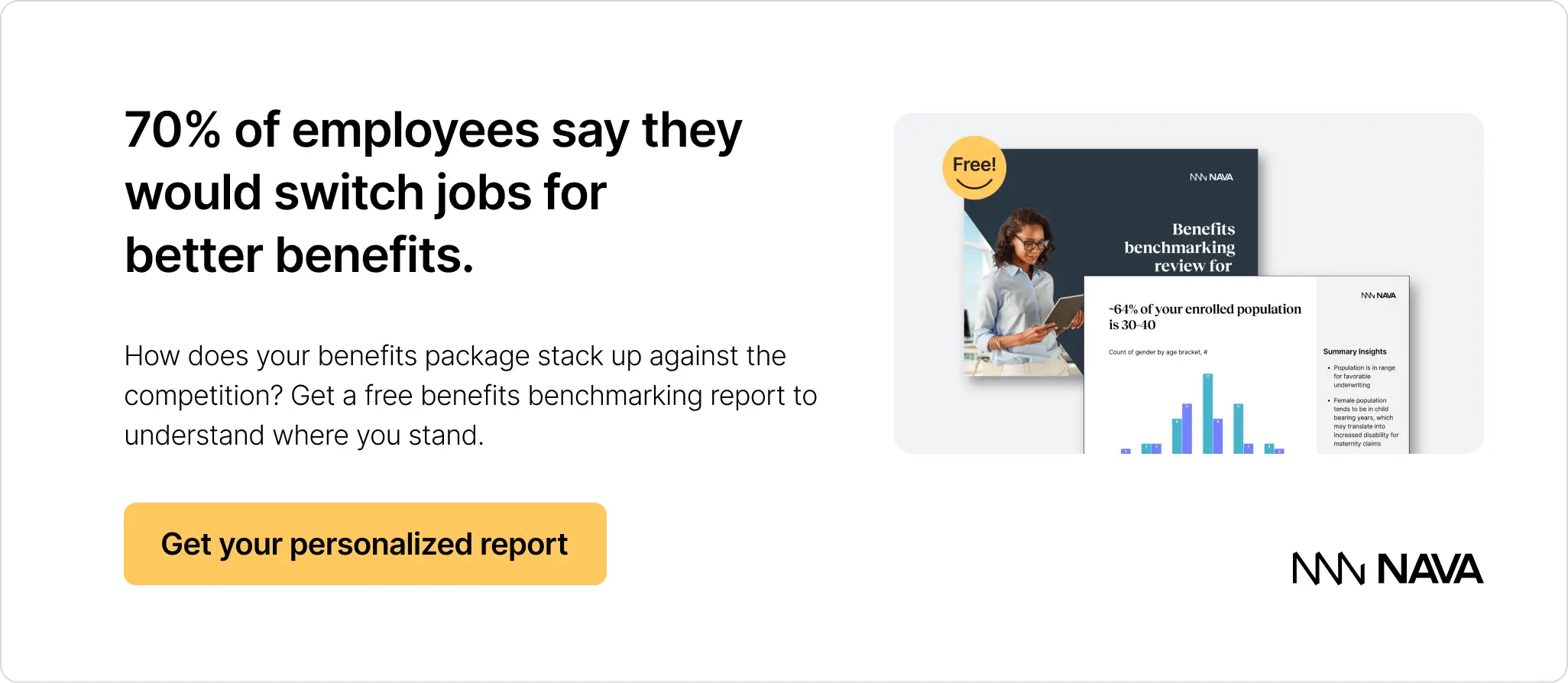Designing an exceptional employee benefits program: a step-by-step guide
.png)
Designing a modern employee benefits program takes more than selecting plans; it requires strategy, data, and empathy. This guide walks HR leaders through eight actionable steps to build a benefits program that attracts talent, strengthens culture, and drives long-term engagement.
A thoughtful employee benefits program is one of the most powerful tools a company has to attract and retain talent. When employees feel genuinely cared for, they’re 1.3 times more likely to stay and 1.2 times more likely to be productive, according to recent HR industry research. For HR leaders at small to mid-size companies, that’s a clear signal that investing in a well-designed employee benefits strategy isn’t just about offering perks—it’s about building a culture of care that fuels engagement, loyalty, and long-term business success.
How to build an employee benefits program that delivers
Designing a truly effective employee benefits program takes planning and intention. It’s not just about selecting benefits from a standard list, but aligning your offerings with employee needs, company values, and financial realities. For many HR leaders, the challenge lies in balancing meaningful benefits with cost efficiency while ensuring every offering contributes to engagement and retention.
To make that process easier, we’ve outlined an eight-step framework to help you design a modern, data-driven employee benefits strategy that supports your people and strengthens your business. Each step provides a practical guide to building a program that’s equitable, sustainable, and ready to grow with your organization.
Step 1: Collect and analyze employee data to understand needs
A successful employee benefits strategy starts with understanding what your people truly value. To design benefits that engage your workforce and maximize ROI, you need to ground every decision in data, not assumptions.
Ways to identify employee needs:
- Employee surveys: Use pulse or benefits surveys to measure satisfaction with existing benefits and identify gaps. Ask questions like “Which benefits do you value most?” and “What programs would make you feel more supported at work?”
- Focus groups: Facilitate small, cross-functional discussions to uncover qualitative insights that numbers can’t capture. This helps you understand nuances, like what “flexibility” or “work-life balance” mean to different employee groups.
- Utilization data: Analyze participation data from your health insurance, wellness, and HRIS platforms. Low utilization may indicate poor communication or irrelevant offerings, while high engagement highlights benefits worth expanding.
- Demographic data: Review workforce demographics like age, family status, income, location, and tenure to anticipate benefit preferences. For example, younger employees might prioritize student loan repayment or professional development, while parents may value childcare assistance or flexible schedules.
- Exit and stay interviews: Collect direct feedback on how benefits influence retention decisions. If employees frequently mention benefits as a reason for staying—or leaving—you have valuable insights for redesign.
By grounding your design process in these data sets, you’ll build an employee benefit program that aligns with workforce priorities, improves satisfaction, and delivers measurable results in retention and engagement.
Step 2: Research industry trends and competitor practices
To stay competitive, HR leaders should regularly review benefits benchmarks in their industry and region. Understanding what other employers offer helps you identify gaps in your employee benefits program and uncover opportunities to stand out.
Start by comparing your current offerings against both industry standards and regional norms. This ensures your benefits are not only cost-effective but also compelling enough to attract and retain top talent.
Where to find reliable benchmark data:
- SHRM Employee Benefits Survey: Offers annual data on benefits trends across industries, including health, retirement, and wellness programs.
- Kaiser Family Foundation (KFF) Employer Health Benefits Survey: A comprehensive look at medical plan design, employer contributions, and employee cost-sharing.
- Local or industry associations: Chambers of commerce and industry-specific HR groups often publish regional benefits data.
- Benefits brokers and consultants: Partners like Nava can provide custom benchmarking data tailored to company size, industry, and location.
Pro tip: When analyzing benchmarks, look for both prevalence (how many employers offer a benefit) and participation (how many employees use it). A benefit that’s widely offered but rarely used might not deliver value, while a niche program with high engagement could be a competitive differentiator.
Finally, look beyond traditional offerings. Many employers now include mental health support, financial wellness resources, and flexible work benefits as part of their core employee benefits strategy. Even if your budget is smaller, you can adapt high-impact ideas that align with your company’s culture and employee demographics.

Step 3: Align benefits with company culture
Your benefits should reinforce your company’s identity. A strong employee benefits strategy connects what you offer with what you stand for.
If your organization values learning and innovation, consider tuition reimbursement or career development allowances. If wellness is a core value, invest in programs that support mental health, fitness, or family well-being. When your benefits reflect your culture, employees feel more connected and valued.
Step 4: Balance cost and value
A sustainable employee benefits program provides meaningful value without overspending. Start by defining your total benefits budget, then assess how each offering contributes to retention, satisfaction, or productivity.
Use data from previous years, like participation rates or claims, to determine which benefits deliver the best ROI. Prioritize programs that both employees appreciate and that drive measurable outcomes for your organization.
Step 5: Build a comprehensive benefits package
A balanced employee benefits program covers three core areas:
- Health benefits: Medical, dental, vision, and mental health coverage that supports physical and emotional well-being.
- Financial benefits: Retirement plans, stock options, or financial coaching that help employees build long-term security.
- Lifestyle and wellness benefits: Paid time off, tuition reimbursement, flexible schedules, or fitness programs that promote balance and growth.
Combining these categories creates a holistic benefits offering that appeals to employees at all stages of life.
Step 6: Communicate and roll out the program effectively
Even the best employee benefit program will fall flat if employees don’t understand it. A strong communication strategy ensures your team knows what’s changing, how to take action, and why your benefits matter. Here’s how to communicate effectively:
Craft clear, employee-centered messaging
- Focus on what’s in it for employees
- Use plain language to explain complex benefits terms
- Lead with empathy: benefits are about care, not compliance
- Highlight what’s new or improved this year and how it supports employee well-being
Segment your audience
- Tailor your communication to different demographics or work groups
- Younger employees may prefer short videos or mobile-friendly graphics
- Tenured staff may respond better to in-person sessions or detailed guides
Choose the right mix of channels
- Digital tools: Leverage email campaigns, intranet posts, and employee portals for announcements and enrollment reminders
- Live interactions: Host webinars, Q&A sessions, or manager-led huddles to walk through plan changes
- Printed and visual aids: Provide one-pagers, infographics, or comparison charts to simplify complex information
Empower messengers and measure impact
- Enlist internal champions like HR business partners, managers, or peer advocates to reinforce key messages
- Partner with your benefits broker or vendors to provide expert Q&A or pre-drafted content
- Track engagement through open rates, attendance, and enrollment analytics to learn what resonates
Simplify the enrollment experience
- Make sign-up intuitive and mobile-accessible
- Offer live support via chat or short help sessions
- Remove friction—clear instructions and friendly reminders go a long way
Employees often spend fewer than 20 minutes reviewing benefit options each year, and many say communication is the biggest barrier to enrollment confidence. Clear, accessible messaging ensures your employee benefits strategy isn’t just well-designed, but understood, appreciated, and fully utilized.
Step 7: Measure and improve your benefits program
After launch, track how employees use and perceive your employee benefits program. Set key performance indicators (KPIs) like participation rates, satisfaction scores, and cost per employee.
Collect feedback through post-enrollment surveys and annual check-ins. When you identify low-engagement benefits, adjust your offerings or renegotiate vendor terms. Continuous evaluation keeps your benefits strategy aligned with employee needs and company goals.
Step 8: Adapt to evolving workforce needs
Employee expectations evolve, especially as your workforce grows or diversifies. Stay agile by reviewing your employee benefits strategy annually and adjusting for new trends or demographic shifts.
For example, if you expand internationally, localize benefits to meet regional requirements. Keep an eye on emerging trends like fertility support, mental health stipends, or caregiving assistance. Staying proactive helps your employee benefits program remain relevant and competitive.
Real-world inspiration: benefits programs that work
To see what an intentional, employee-centered employee benefits program looks like in practice, take RRM Design Group: a 200-person, employee-owned architecture and planning firm based in California. When the team realized their benefits communication and engagement weren’t keeping pace with employee expectations, they partnered with Nava to modernize their approach.
Together, they introduced HQ for Employees, Nava’s app for employees and their families, to make plan information easy to access on mobile. They also expanded engagement beyond open enrollment with year-round wellness challenges, like hydration and step-tracking initiatives that keep employees motivated and connected.
By combining technology, feedback (via employee surveys), and an ongoing wellness focus, RRM built an employee benefits strategy that reflects its culture of collaboration and continuous improvement. “Benefits are a confusing topic,” said Erica Gonzales Hopp, HR Manager at RRM Design Group. “Anything we can do to make it simpler is helpful.” That focus on clarity and accessibility has become the cornerstone of their employee benefit program, helping employees feel supported, informed, and cared for year-round.
Empower your workforce with a thoughtful employee benefits strategy
A strong employee benefits program is more than a perk—it’s a strategic investment in your people and your business. By following these steps, HR leaders can design a benefits strategy that supports employee well-being, builds loyalty, and drives long-term success.
Ready to reimagine your employee benefit program? Nava helps small and mid-size employers design, implement, and manage benefits that make a real impact. Talk to an expert today.
.webp)





.webp)
